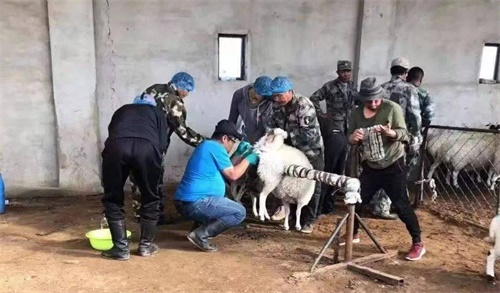As a goat farmer, recognizing twin pregnancies early can significantly affect herd management, nutrition planning, and overall farm productivity. Twin pregnancies in goats offer higher profitability due to the potential for two kids per gestation, but they also present unique management challenges. Today, compact ultrasound devices are transforming how farmers detect twin pregnancies, offering a non-invasive, reliable, and efficient solution. In this article, I will explain how we use compact ultrasound technology to identify twin pregnancies in goats, and why early detection is critical for modern livestock operations.

Understanding Twin Pregnancies in Goats
Goats are naturally prolific breeders, with multiple births being quite common depending on breed, genetics, and management. Twin pregnancies are especially valued in meat and dairy goat production systems because they increase the output per doe. However, they require more intensive monitoring to ensure the health of both the dam and the kids. Early identification allows for tailored feeding, veterinary care, and preparation for potential birthing complications.
Compact Ultrasound Devices: A New Era in Reproductive Management
Traditional pregnancy detection methods in goats have included palpation, behavioral observation, and hormone assays. While useful, these techniques have limitations in accuracy, timeliness, and invasiveness. Compact ultrasound devices, particularly portable B-mode ultrasound units, have emerged as a game-changer for reproductive management on the farm.
These handheld or backpack-sized devices offer high-resolution imaging that can detect pregnancies as early as 25-30 days post-breeding. More importantly, experienced operators can often identify multiple embryos and amniotic sacs, providing valuable information about litter size. Their portability allows for on-site scanning directly in the barn or pasture, minimizing animal stress and maximizing convenience.
Advantages of Early Twin Pregnancy Detection
Early identification of twin pregnancies provides several key benefits:
Nutritional Management: Twin-bearing does have higher nutritional needs, especially in the last trimester. Early detection allows farmers to adjust feed formulations to support fetal development and prevent complications such as pregnancy toxemia.
Veterinary Monitoring: Twin pregnancies carry a higher risk of dystocia (difficult birth) and other complications. Knowing the number of fetuses allows for proactive veterinary interventions and birthing assistance plans.
Economic Planning: Farmers can better forecast kid crop size, milk production expectations, and resource allocation when twin pregnancies are identified early.
Selective Breeding Decisions: Accurate pregnancy records help refine breeding programs by selecting does with consistent twinning ability, thereby improving long-term herd genetics.
Using Ultrasound Imaging to Detect Twin Pregnancies
The process of ultrasound scanning for pregnancy in goats typically involves transabdominal scanning. Here's how it's performed:
Timing: Scans are ideally performed between 30-50 days post-breeding to achieve the highest accuracy in identifying twins.
Preparation: The abdominal hair may be clipped, and a coupling gel applied to ensure optimal probe contact.
Probe Placement: The probe is placed on the right side of the abdomen, angled towards the uterus.
Image Interpretation: On-screen images show fluid-filled sacs, fetal structures, and heartbeats. Twin pregnancies are indicated by the presence of two distinct embryonic sacs or fetuses.
With practice, even farmers with minimal training can learn to operate compact ultrasound devices effectively. However, veterinary guidance is recommended to ensure accuracy during initial adoption.

Challenges and Considerations
Despite its advantages, ultrasound detection of twin pregnancies does require attention to several factors:
Operator Skill: Accurate interpretation requires training and experience. Misidentifying multiple sacs as one or overlooking one fetus can lead to incorrect management decisions.
Equipment Quality: The resolution and depth capacity of the ultrasound unit directly impact detection success. High-quality compact devices balance portability with imaging clarity.
Breed Differences: Certain breeds may have more deeply positioned fetuses or smaller uterine horns, making detection more challenging.
Comparing Ultrasound to Traditional Methods
To appreciate the value of compact ultrasound devices, it's helpful to compare them with older methods:
| Method | Accuracy | Invasiveness | Timing |
|---|---|---|---|
| Palpation | Low to moderate | High | Late gestation |
| Hormone Assays | Moderate | Low | Mid-gestation |
| Behavioral Observation | Low | None | Post-breeding |
| Compact Ultrasound | High | None | Early gestation |
In terms of early twin pregnancy detection, compact ultrasound clearly outperforms traditional methods, offering both speed and precision.
Global Perspectives on Ultrasound Use in Goat Farming
Internationally, the adoption of portable ultrasound technology in goat farming has been increasing steadily. In countries like Australia, New Zealand, and parts of Europe, where commercial goat operations are highly advanced, compact ultrasound devices are routinely used for pregnancy checks. American goat farmers, especially those in commercial dairy and meat goat operations, are also embracing this technology to stay competitive and efficient.
In contrast, many developing countries are just beginning to access this technology due to cost and availability. However, as prices drop and training becomes more accessible, global use is expected to rise, bringing the benefits of early twin pregnancy detection to more farmers worldwide.
Real-Life Farm Experiences with Compact Ultrasound
On my farm, the shift to compact ultrasound devices has revolutionized our breeding program. Before adopting ultrasound, we often relied on visual observation and body condition scoring, which left us uncertain about litter size until kidding time. This unpredictability made it challenging to allocate resources efficiently.
Now, within a month of breeding, we know which does are carrying twins. We adjust their feeding programs early, supplementing with additional energy and protein. Veterinary checks are scheduled proactively for high-risk pregnancies. Our kidding survival rates have improved, and we face fewer unexpected complications.
Additionally, our breeding program has become more selective. We track twinning records and prioritize breeding does with consistent twin pregnancies. This data-driven approach is directly supported by accurate ultrasound records.
Future Developments in Compact Ultrasound Technology
As technology advances, compact ultrasound devices continue to evolve. Key trends include:
Wireless Connectivity: New models offer real-time image streaming to tablets or smartphones, allowing remote veterinary consultations.
AI Integration: Some devices incorporate artificial intelligence to assist with image interpretation, reducing operator error.
Battery Life Improvements: Longer operational time allows more scans to be conducted without recharging.
Affordability: As manufacturing scales, the cost of compact ultrasound units is decreasing, making them accessible to smaller farms.
Conclusion
For goat farmers, early identification of twin pregnancies using compact ultrasound devices offers a reliable, non-invasive tool to enhance herd management, improve animal welfare, and maximize economic returns. The technology empowers farmers to make informed decisions about nutrition, veterinary care, and breeding, ultimately supporting more efficient and sustainable livestock operations.
While there is a learning curve, the long-term benefits far outweigh the initial investment. As these devices become more affordable and user-friendly, their adoption is set to grow worldwide, helping farmers better manage the complexities of goat reproduction.
Reference Sources:
Smith, J.L., & Brown, K.A. (2022). Advances in Caprine Reproductive Ultrasonography. Journal of Small Ruminant Reproduction.
International Goat Research Center. (2023). "Ultrasound Use in Goat Reproductive Management."
tags:


